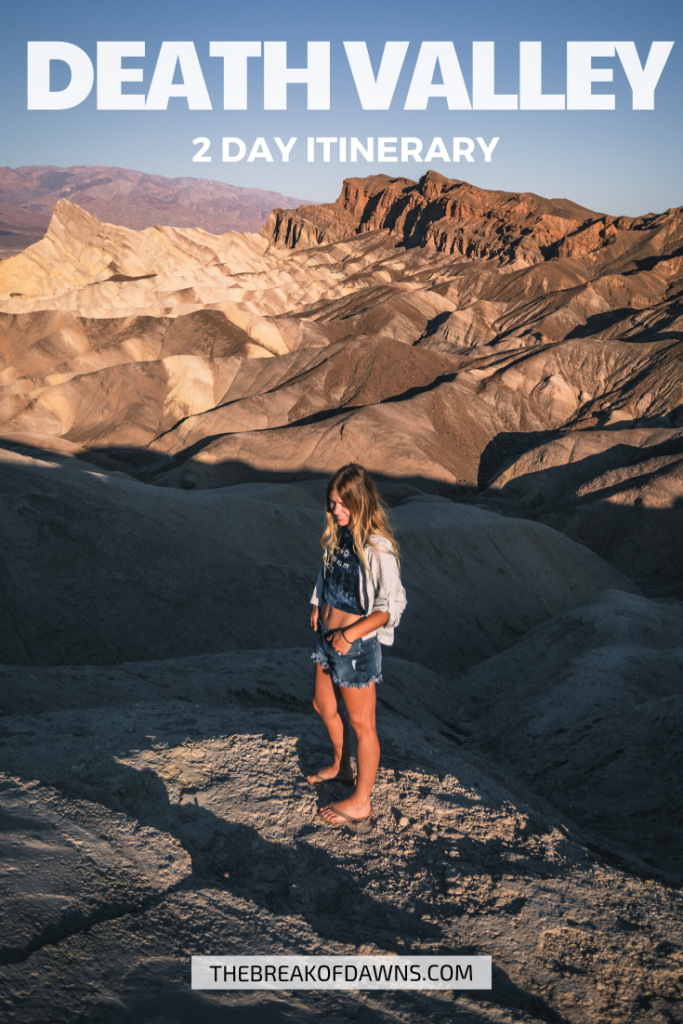
This world is jam-packed of National Parks, all unique for the ecosystems and geological masterpieces found there. This slice of land in the northern Mojave is so unique, it even breaks world records. Spending 2 days in Death Valley will be one of your more memorable trips; it’s the most otherwordly place I’ve ever been.
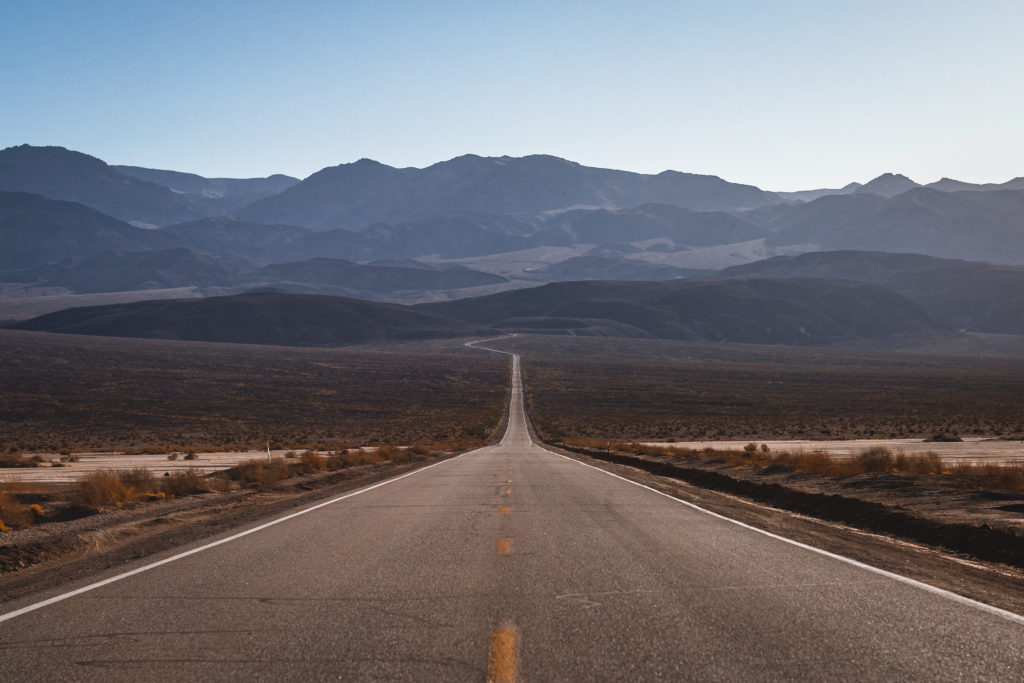
Getting to Death Valley
Since it’s located about 2 hours from Las Vegas, most visitors to Death Valley fly into there. From Vegas, either embark on a group tour by bus or rent a car for the 2 hour drive.
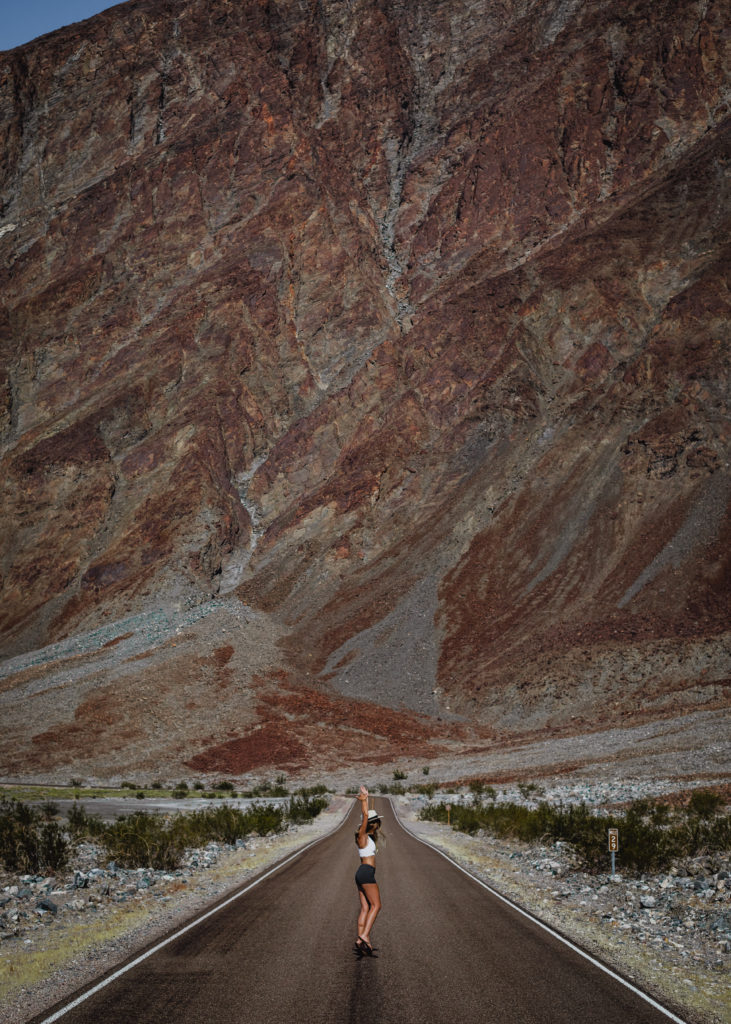
I highly recommend renting a car for Death Valley. This gives you the freedom to explore the wilderness area on your own. It’s important to note that a lot of the roads in this itinerary may require well-treaded tires and high-clearance vehicles.
Click here for current updates on conditions/alerts in Death Valley
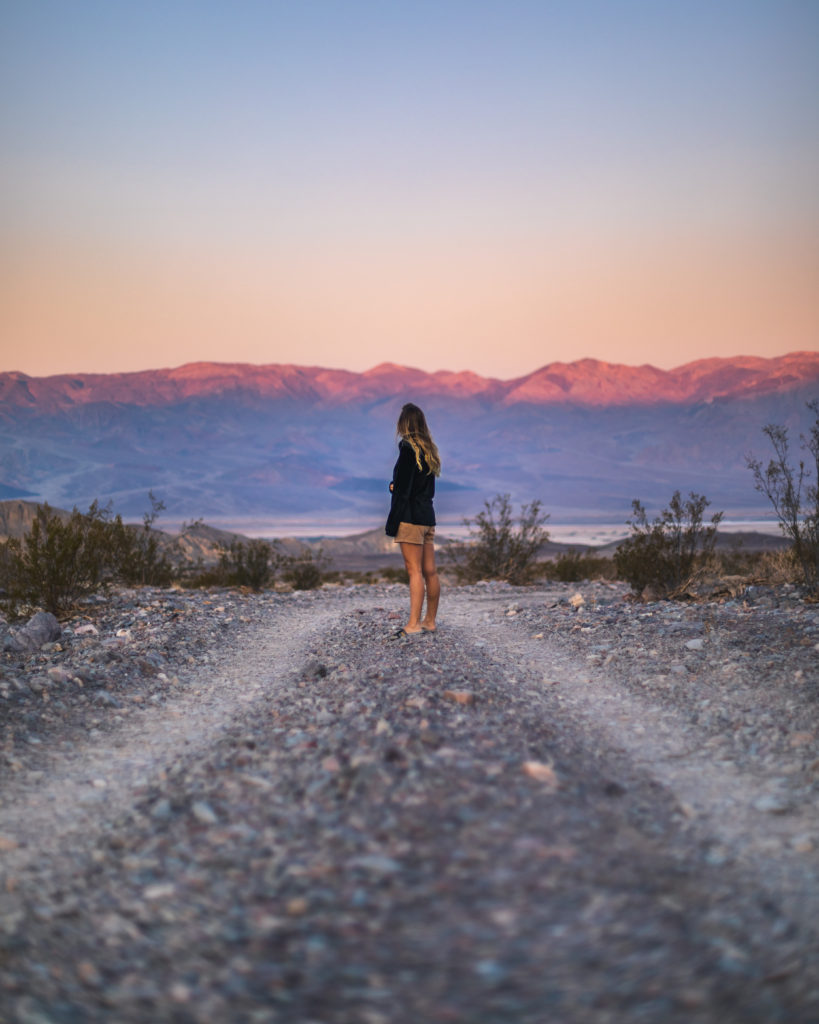
Where to Stay in Death Valley
If you’re not camping in Death Valley, there are a few places to stay within the park and on the outskirts. With a land area so massive, try and pick a location better suited to where you’ll be exploring.
Staying in the Park
Lodging options in the park are centrally-located at the Panamint Springs Resort, the Ranch at Death Valley, at The Oasis, or the Stovepipe Wells Village. Camping is available at various campgrounds on a first-come, first-serve basis, as well as RV parking at Furnace Creek. Backcountry camping is a free option with a permit from the visitor center. Car camping on backcountry roads is the best way to enjoy Death Valley in my opinion.
Read More: Where to Camp & Car Camp in Death Valley
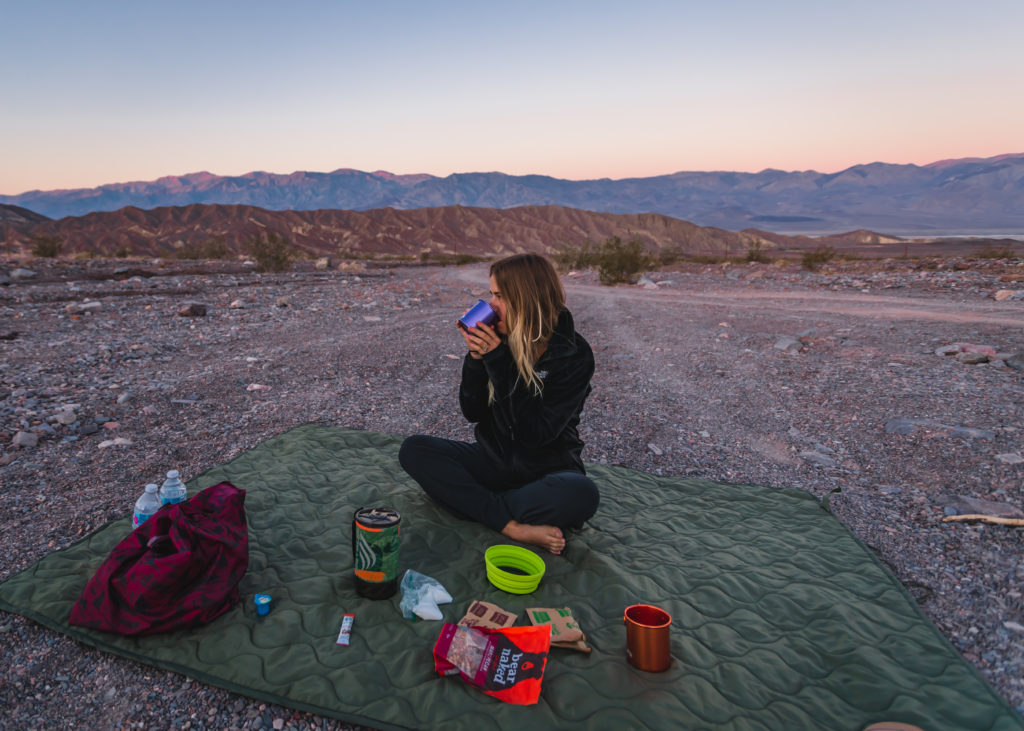
Staying on the Outskirts
On the east side, the closest lodging options in proximity to the park are in Beatty or in Amargosa Valley, both in Nevada. On the west side of the park, the closest accommodation is in Lone Pine, California. I recommend staying at the Longstreet Inn & Casino in Amargosa Valley, a cheaper yet comfortable, casual option just down the road from Dante’s View.
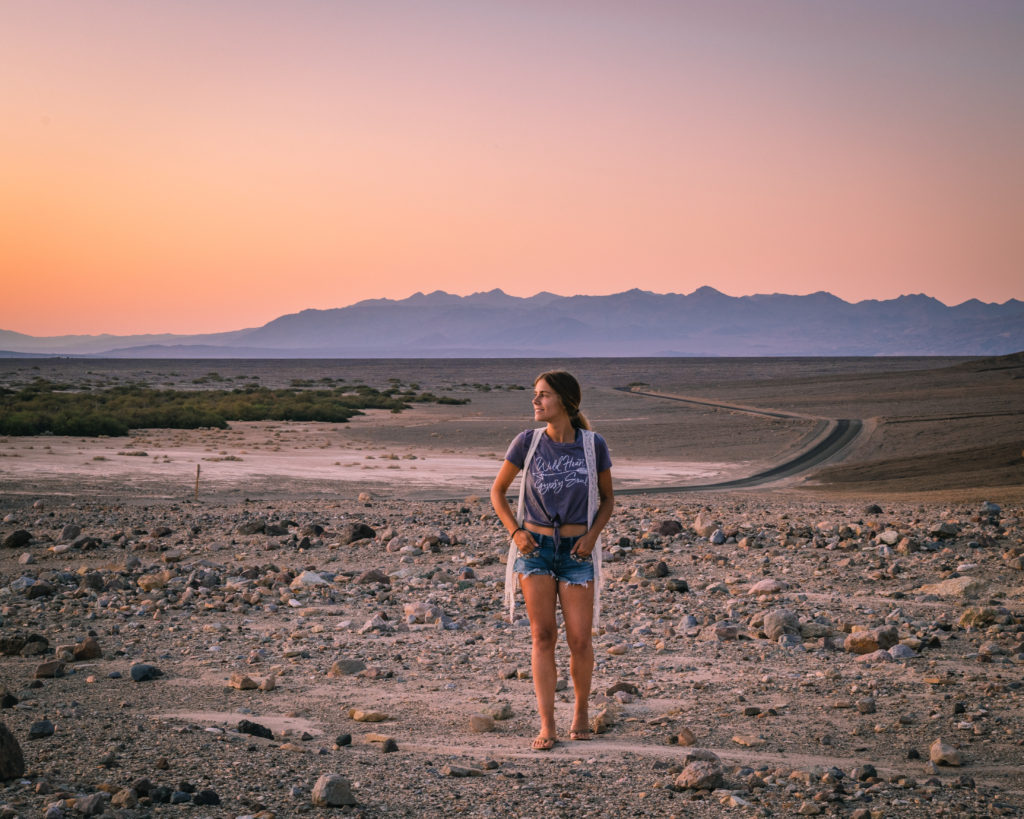
Itinerary Details for 2 Days in Death Valley
This itinerary for 2 days in Death Valley includes multiple short hikes and aloooooot of driving. It features ghost town and abandoned mine explorations, backcountry driving and various options to round out the best of the park.
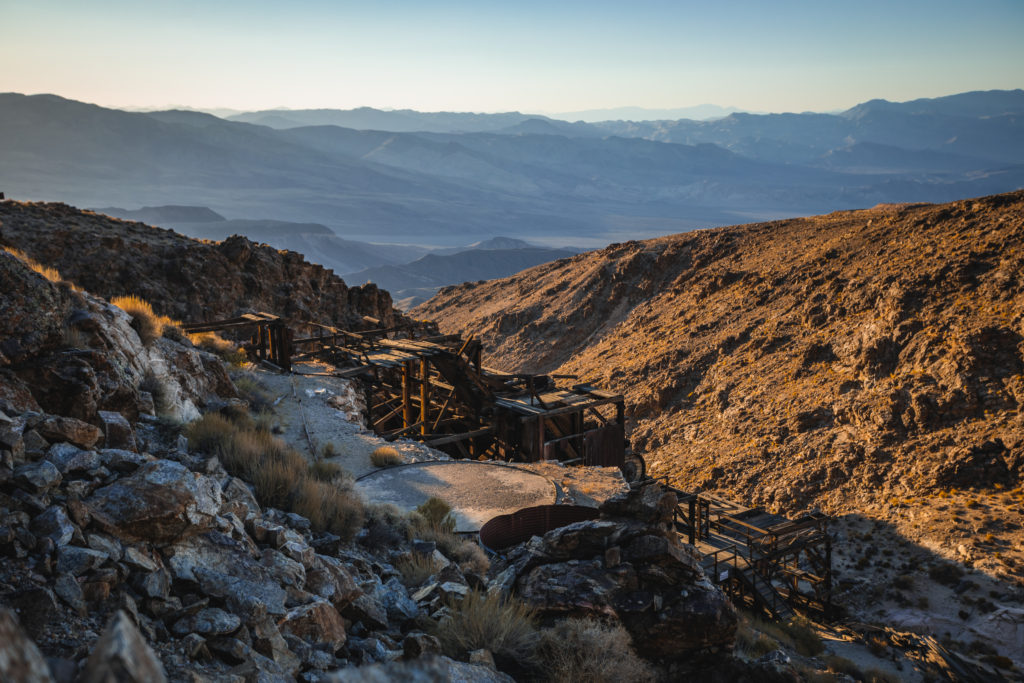
Day 1 in Death Valley
Sidewinder Canyon
Start the trip off with a bang at one of my favorite hikes in the entire park, Sidewinder Canyon. A 4 mile trek through narrow slots, prepare to scramble, crouch, crawl and climb your way through this incredible place.
Read More: Hiking Sidewinder Canyon in Death Valley
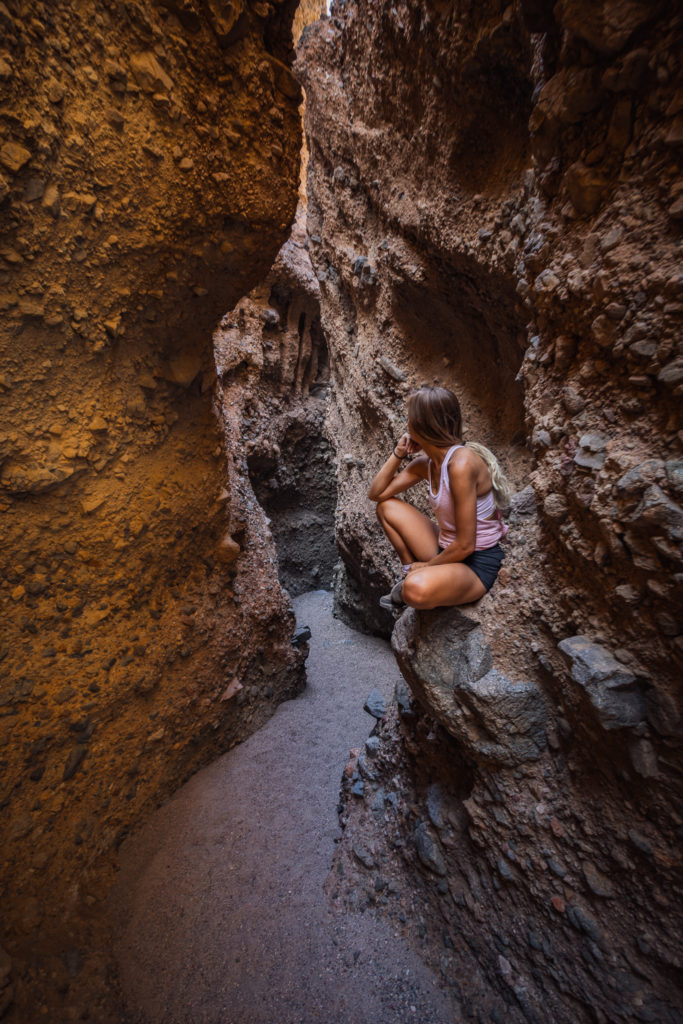
Badwater Basin
Drive 25 minutes north on CA 178 to the massive ancient lakebed of Badwater Basin. This place holds a great deal of significance to Death Valley. Acting as the lowest point in North America, it also holds a record for the hottest air temp on earth at 134.1°F.
Read More: Badwater Basin – Cool Adventures in the Hottest Place on Earth
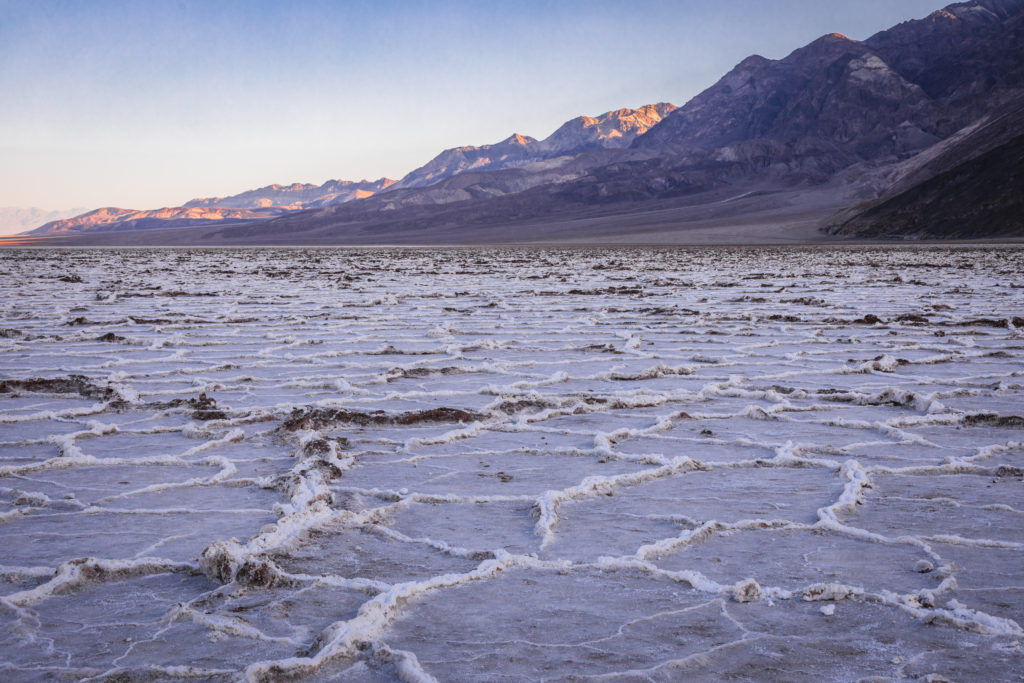
Devil’s Golf Course
Northwest of Badwater Basin, about 2 minutes up the road, is the extremely unique Devil’s Golf Course. Due to millions of years of rain and wind, the salt deposits from the ancient lakebed have turned into crystallized formations.
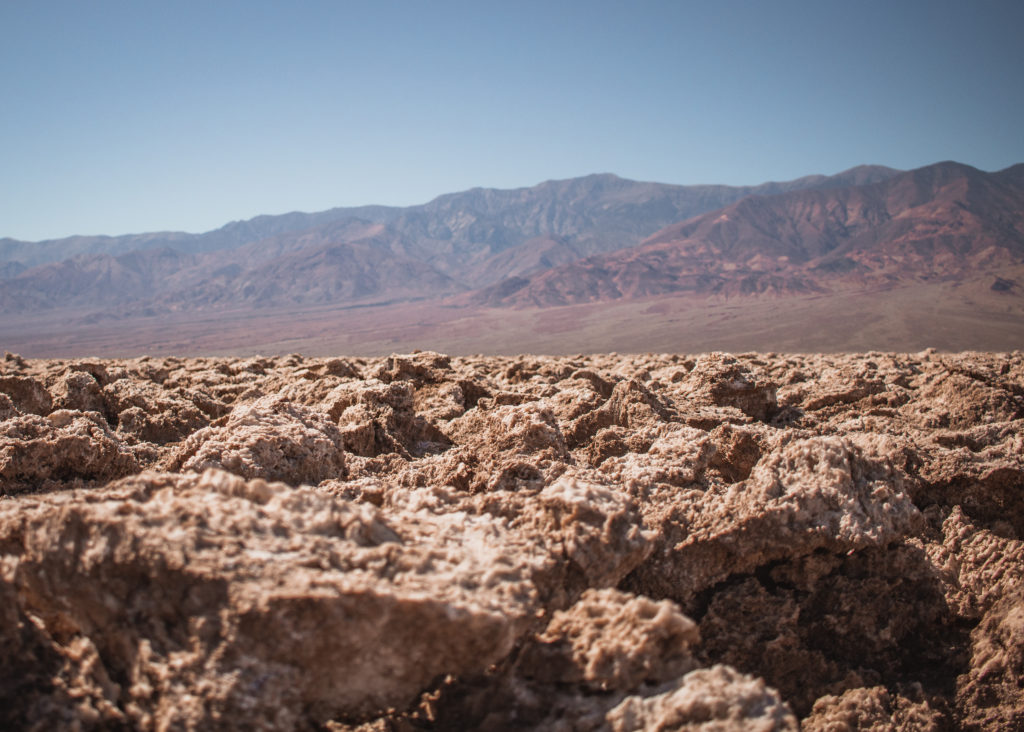
Artists Palette
A little further north is Artists Palette, one of the more popular areas in the park. Found along a one-way 9 mile drive, take your time winding through the colorful mountain ranges complete with ancient dried-up waterfalls and Crayola-colored dirt.
Read More: Cotton Candy Mountains at Artists Palette
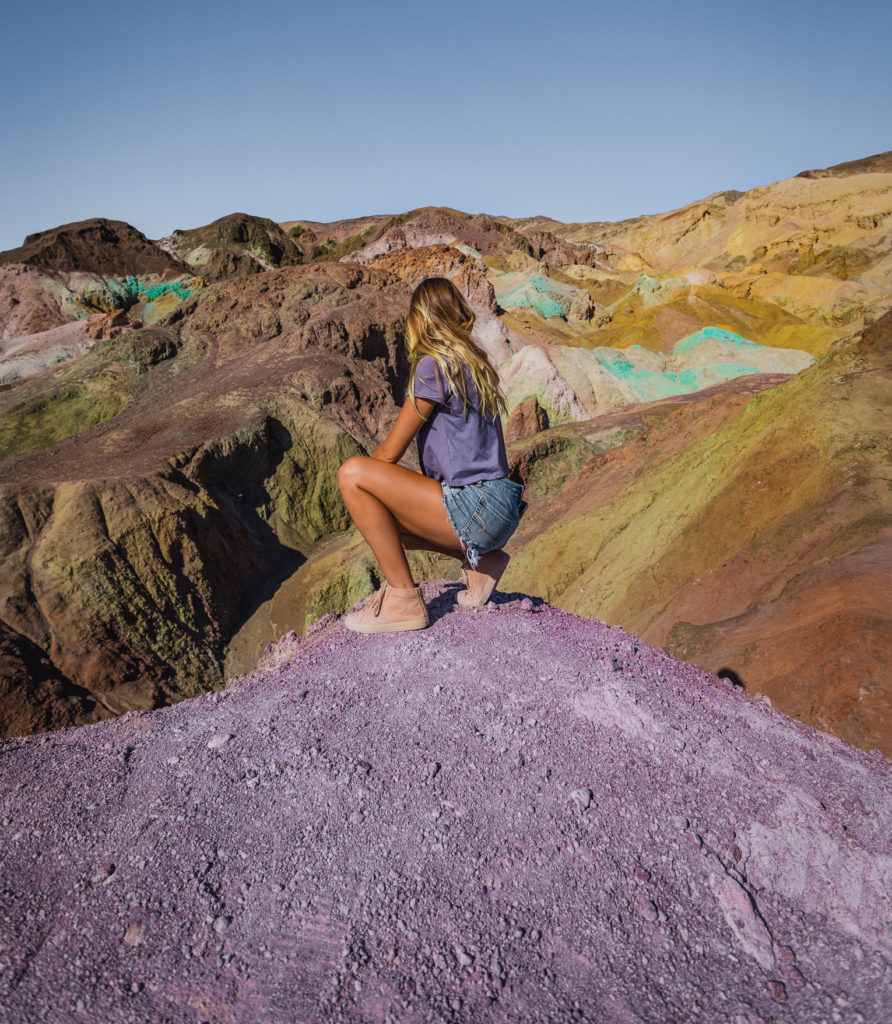
Golden Canyon & Red Cathedral
Another 5 minutes north up the road will bring you to a parking area for the Golden Canyon. Three different trailheads begin here but the shortest is also my favorite, a 3 mile out and back trek to the Red Cathedral.
Read More: Hiking Golden Canyon & Red Cathedral in Death Valley
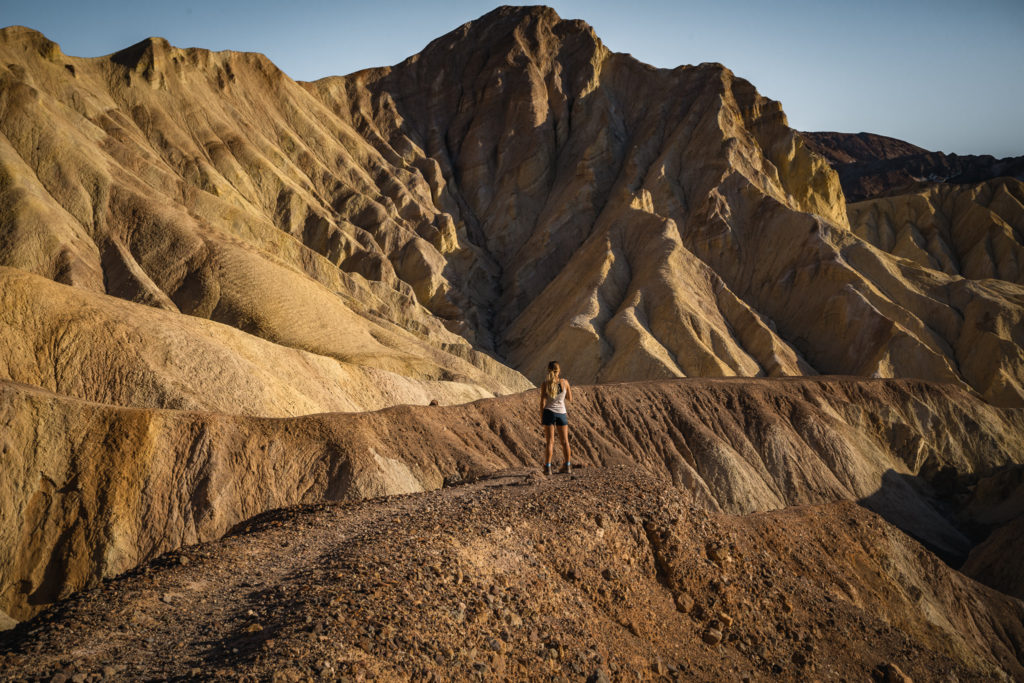
Sunset & Starry Skies
By this time, the sun should be setting, leaving behind those rainbow tones across the desert. Feel free to visit some epic spots for sunset, like at the Mesquite Flat sand dunes.
Read More: The Sand Dunes of Death Valley
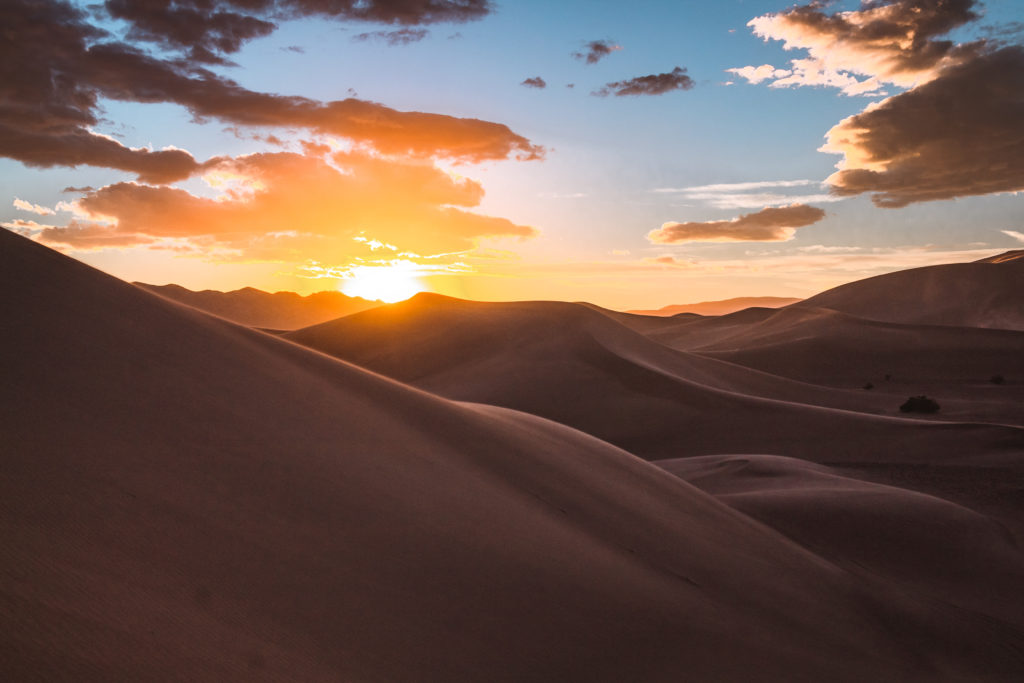
If you’re not too tired and still up for some exploring after the sun goes down, head up to Dante’s View at 5600 feet. With the total darkness of Death Valley married with this elevation, it’s like you can reach out and touch the Milky Way.
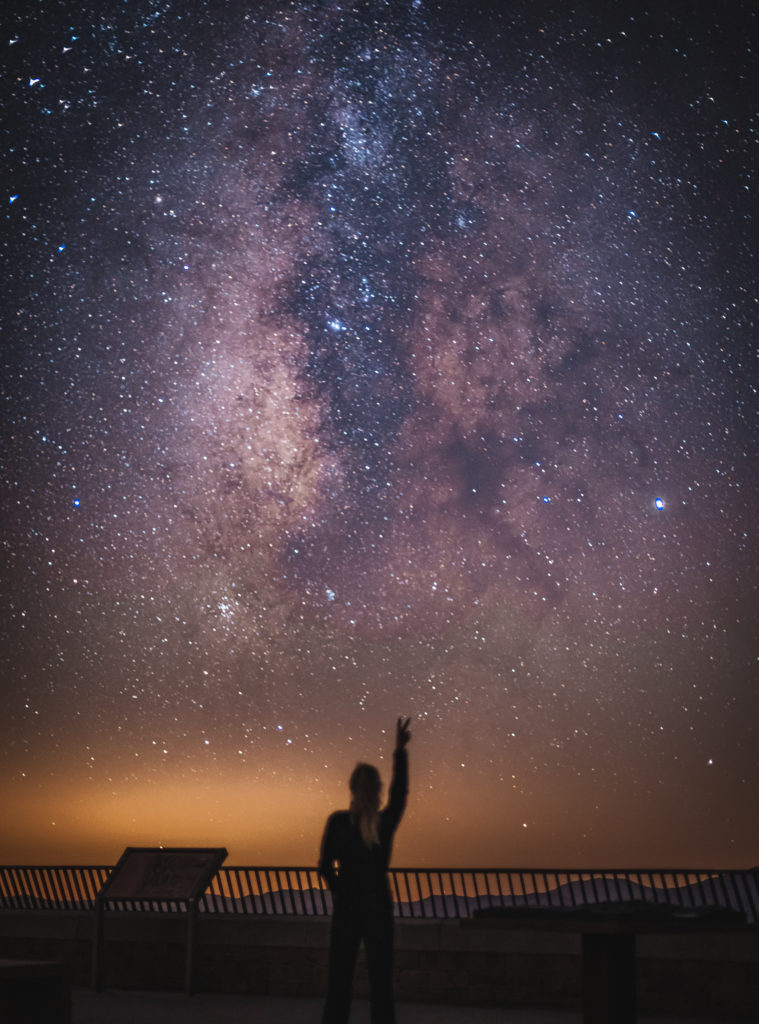
Day 2 in Death Valley
Now that we’ve shaved off the central and southern areas of Death Valley, today is all about the rugged exploring. Let’s start off with one of the best spots to go for sunrise or sunset.
Zabriskie Point
Overlooking the back portion of the Red Cathedral, views of Zabriskie Point displays rolling hills of gold and red badlands. As the sun rises over the horizon, various shadows and tones can be seen along the landscape.
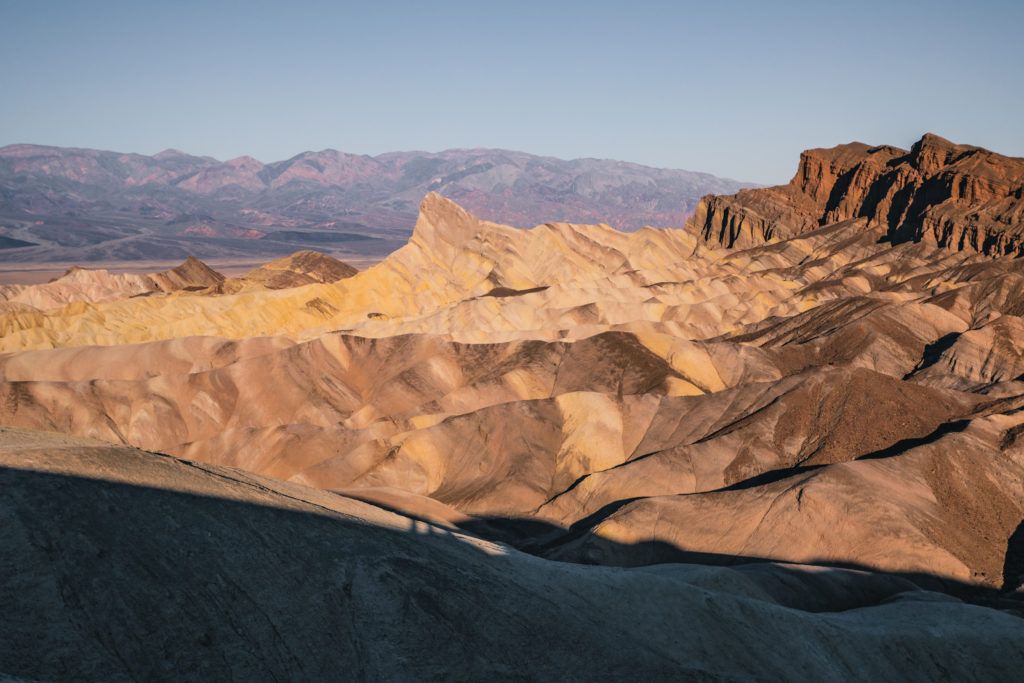
Twenty Mule Teams Canyon
Before heading off on our next adventure, consider stopping by the Twenty Mule Teams Canyon just east of Zabriskie. This area was where the Harmony Borax Company used mule teams of twenty to haul their wagons of borax to the railroad, a 10 day 165 mile trip.
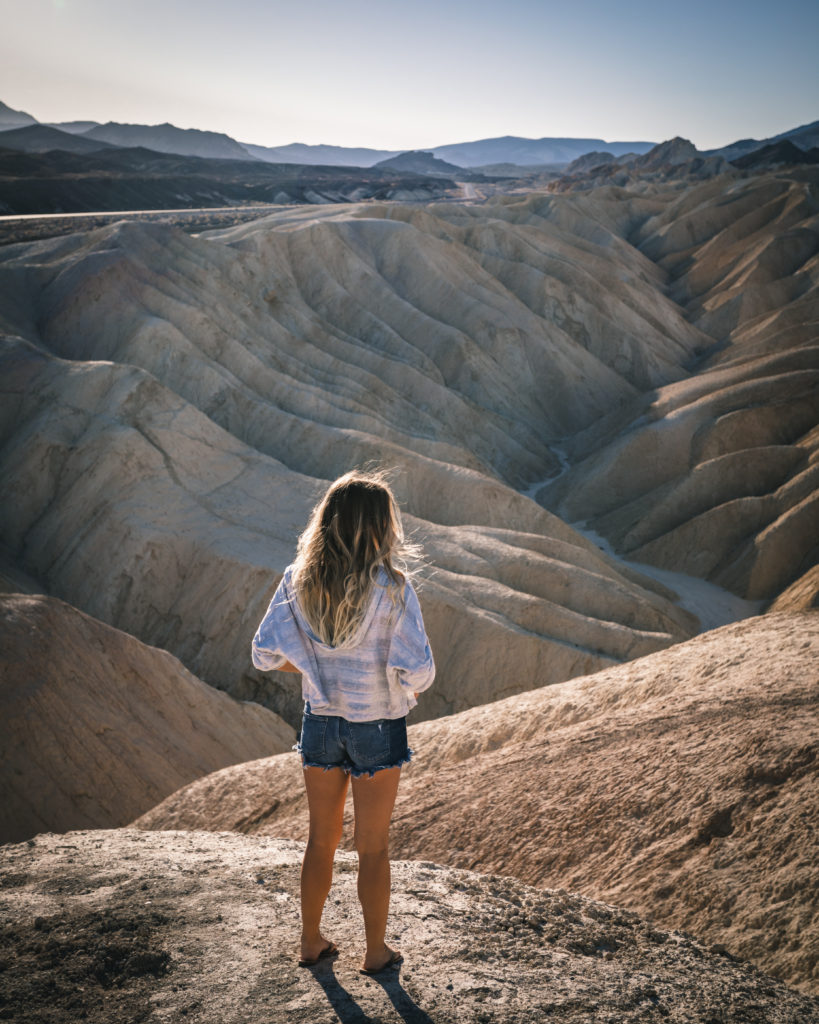
Mine & Mill Ruins
At this point we’ll be heading northwest on CA-190 through Furnace Creek. Take some time to stop by the Harmony Borax Works area, as well as other mine and mill ruins like Chloride City.
Read More: Deserted in the Desert – Mine & Mill Ruins of Death Valley
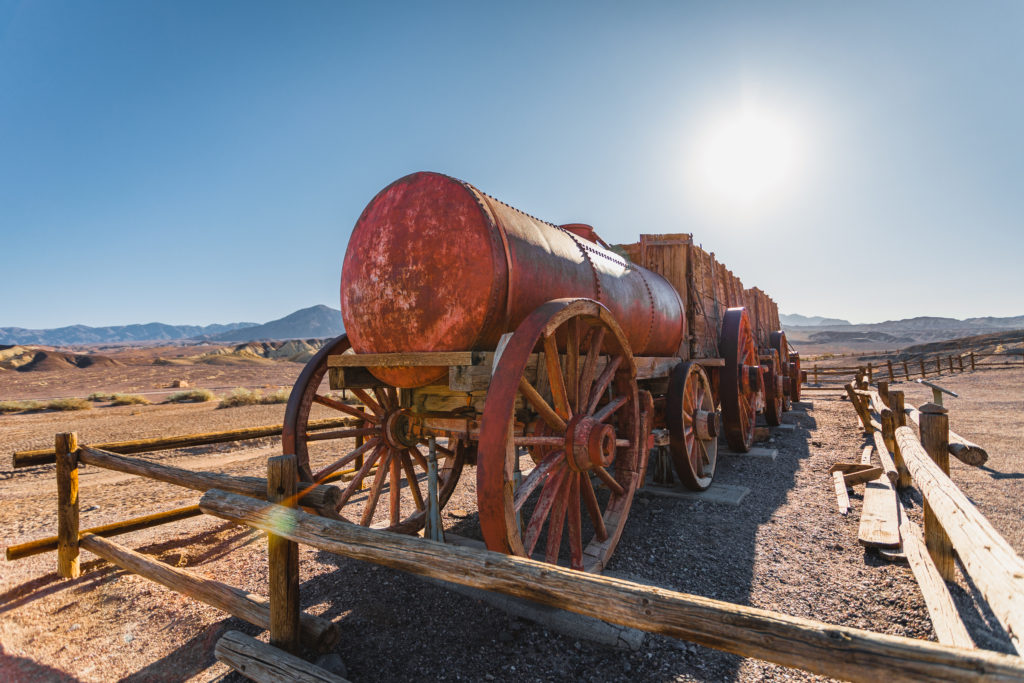
Rhyolite Ghost Town
Heading northeast towards Beatty, Nevada, arrive at the intriguing Rhyolite Ghost Town. Within a single decade, Rhyolite went from being the largest city in southern Nevada to a ghost town.
Read More: Rhyolite Ghost Town – A Worthy Death Valley Detour
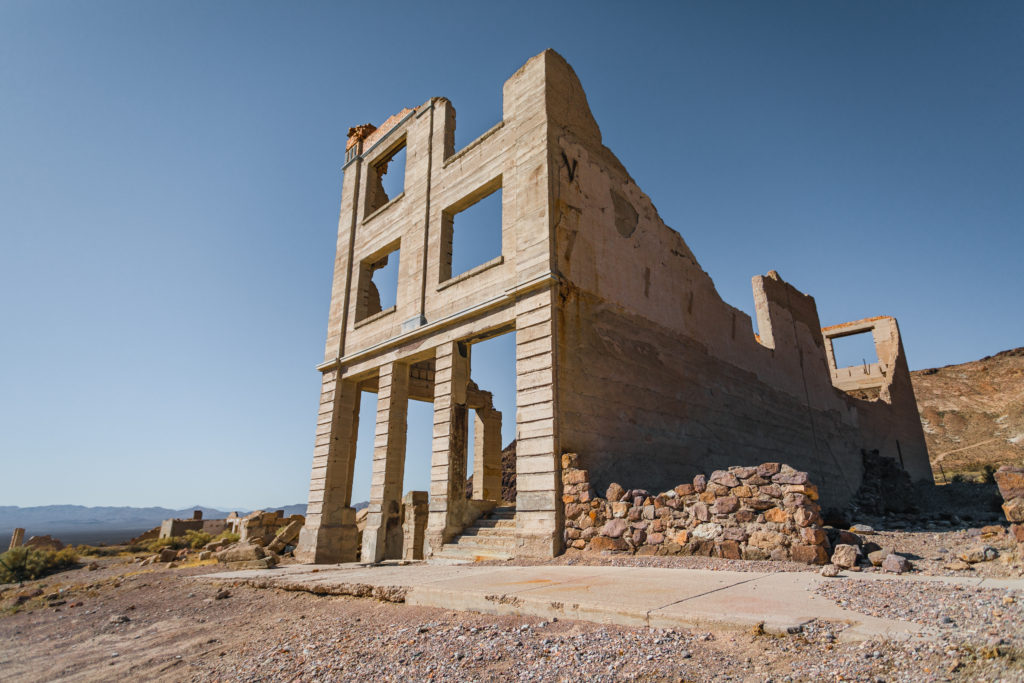
Goldwell Open Air Museum
A can’t-miss spot at the entrance of Rhyolite is the Goldwell Open Air Museum. Featuring more than 7 different sculptured exhibits, it’s the funkiest thing to stumble upon in this vast arid land.
Read More: Funky Desert Decor at the Goldwell Open Air Museum
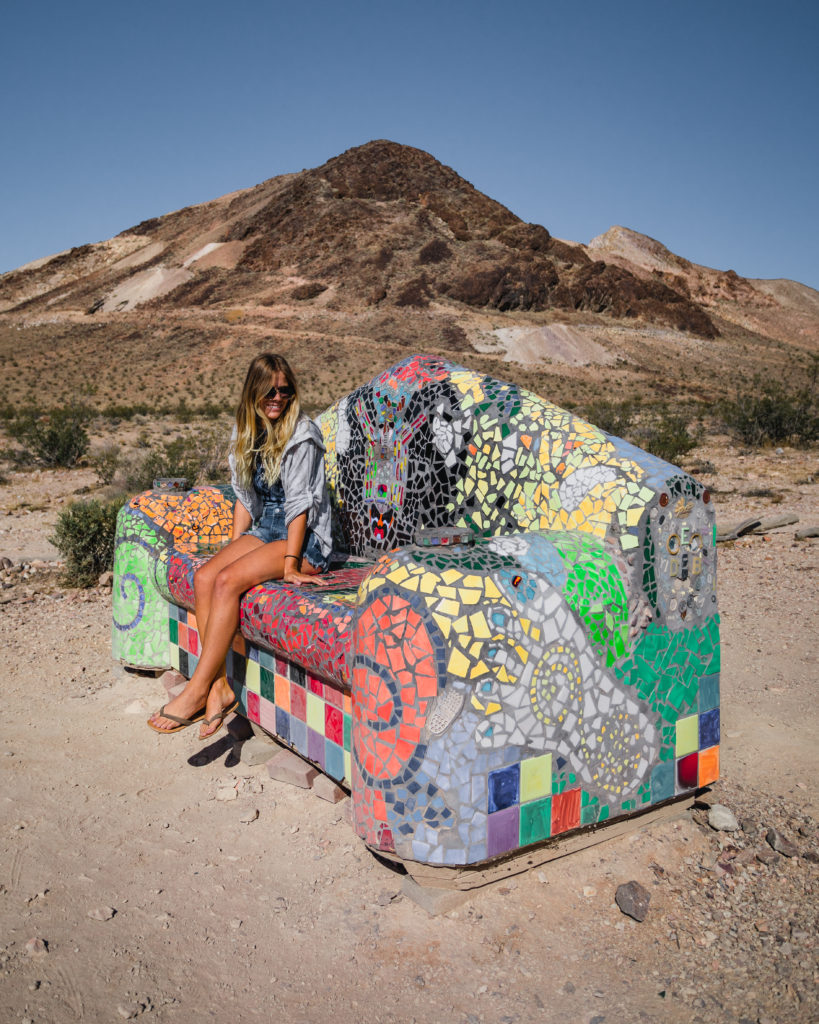
Titus Canyon Road
And now for my favorite activity in all of Death Valley, driving the Titus Canyon Road. Located a couple miles west of Rhyolite, this 27 mile drive has been regarded as “America’s most beautiful backcountry road” since its creation in the late 1800s. Getting through Titus Canyon takes around 2 – 4 hours and is recommended to be driven with a high-clearance vehicle, sometimes requiring 4-wheel drive.
Read More: Titus Canyon Road – Death Valley’s Most Epic Adventure
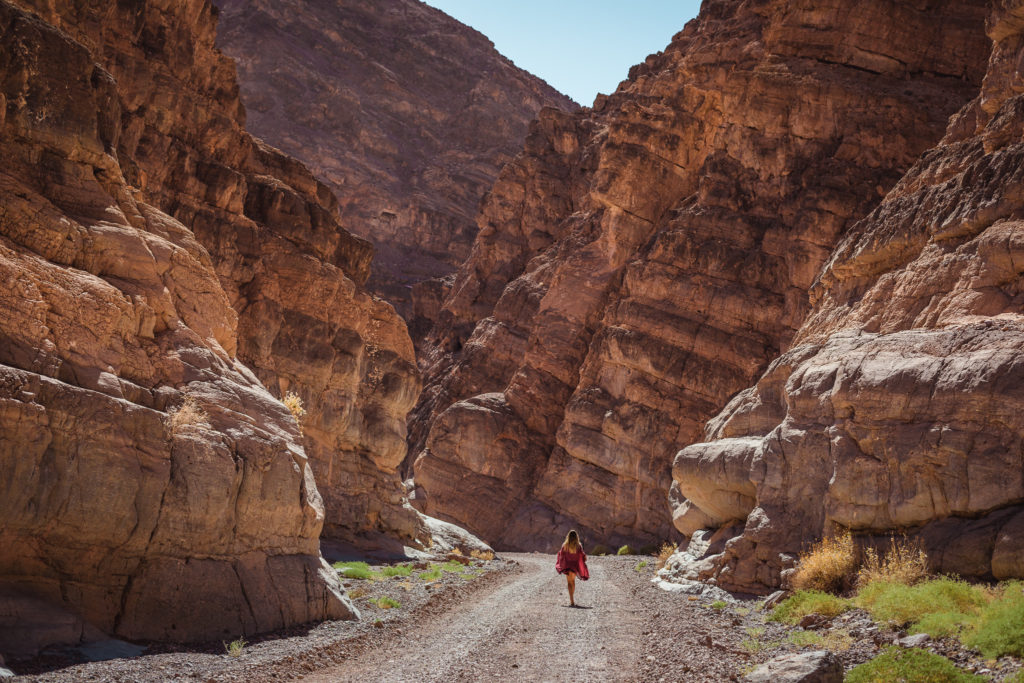
Leadfield Ghost Town
About halfway through Titus Canyon Road is the remnants of the reason why the road was built, the Leadfield Ghost Town. Within 5 months of becoming a town, Leadfield was abandoned by the miners and investors, leaving behind an eery mountainside ghost town.
Read More: Leadfield Ghost Town in Death Valley
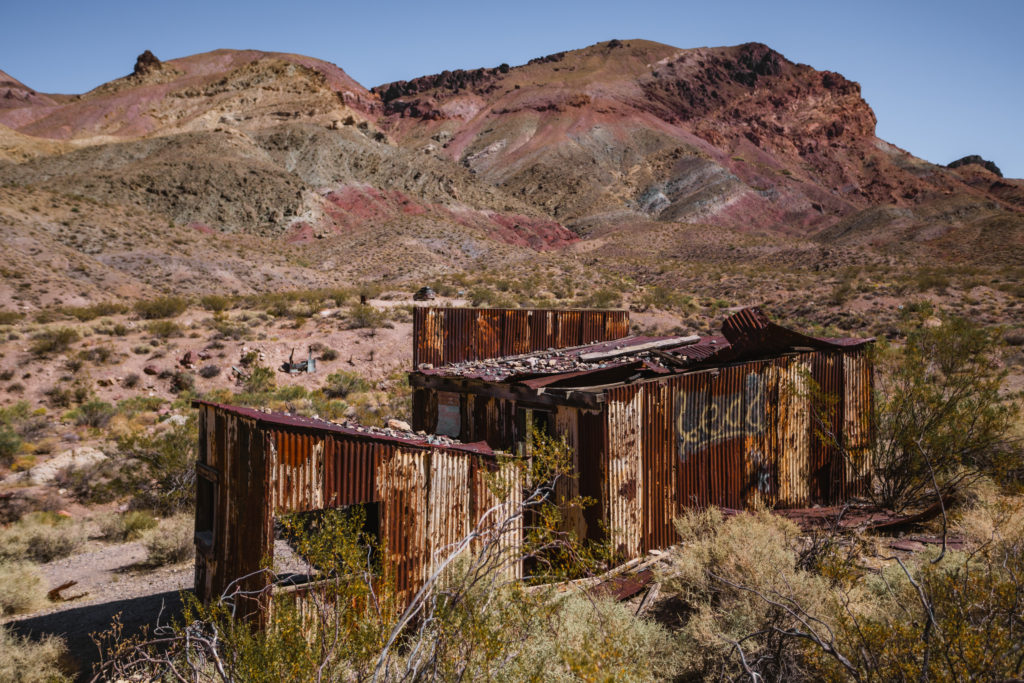
Route Options After Titus Canyon
After completing Titus Canyon Road, you can pick from two different route options from here to finish up the itinerary.
Option A: Taking a Right from Titus Canyon
Taking a right from Titus Canyon, you can visit Scotty’s Castle (closed until Sept 2021) and the Ubehebe Crater, a large volcanic crater more than 600 feet deep. From there, continue on towards the Eureka Sand Dunes, the tallest dunes in California and possibly even North America. Once you’ve reached those dunes, you can then take backcountry roads down to the Racetrack Playa, the large 1000 foot-deep mud pit known for the ‘moving rocks.’
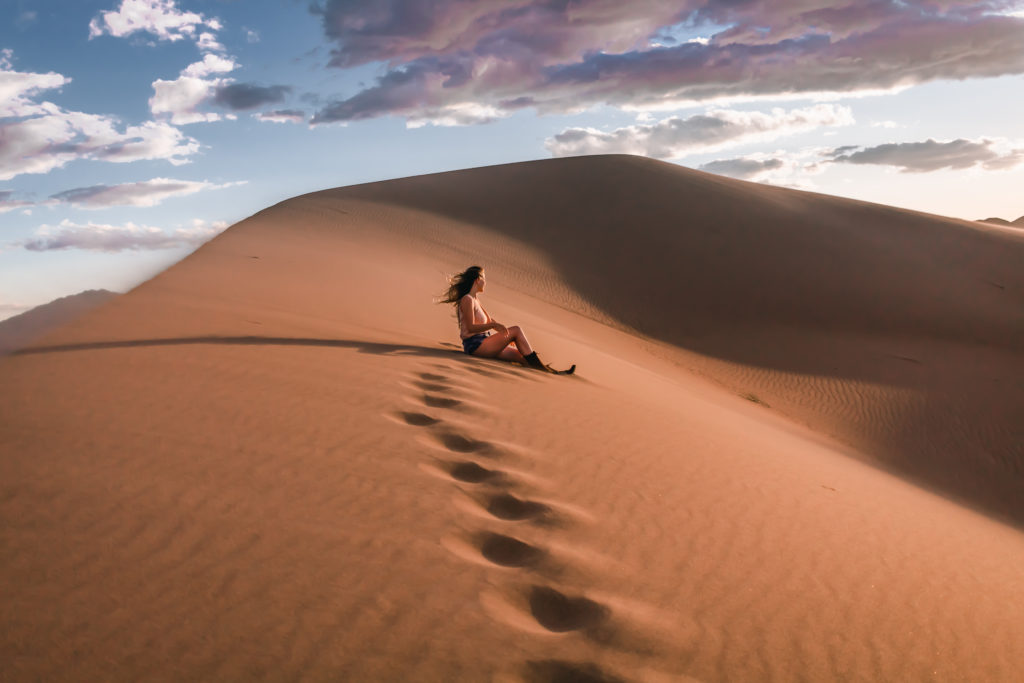
Options B: Taking a Left from Titus Canyon
Upon finishing the Titus Canyon Drive, take a left to heads back towards CA-190. Within a couple of miles you’ll reach the Mesquite Flat Sand Dunes, always a worthy stop for some sand boarding. After exploring there, head west for a few miles, arriving at the incredibly-beautiful Mosaic Canyon.
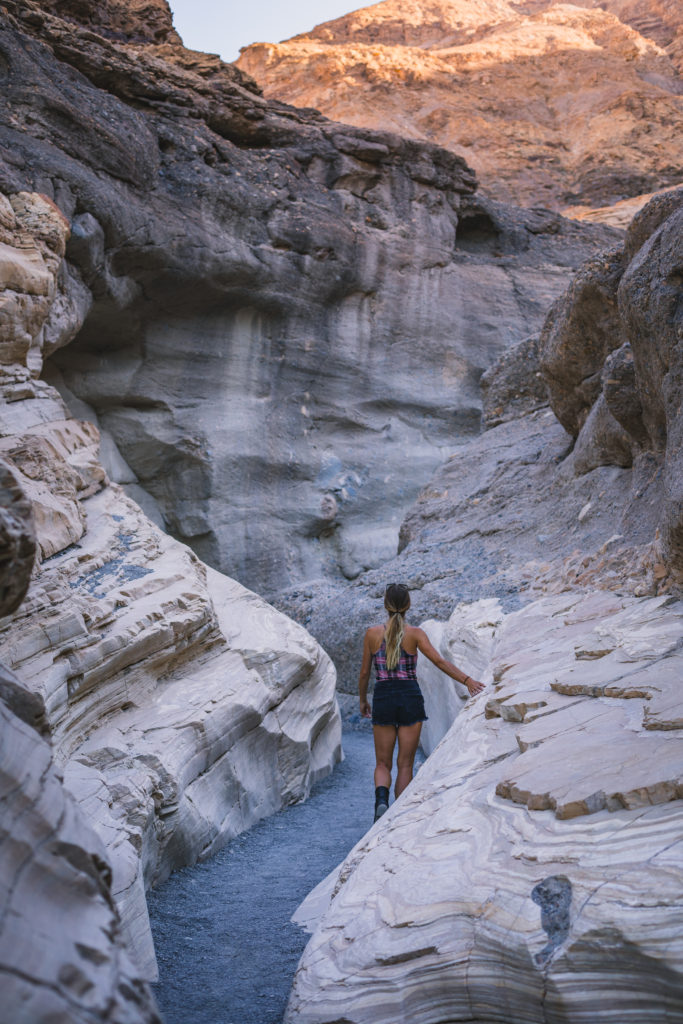
With all this time at low elevation, it’s time to reach new heights in the Panamint Mountains. Heading south on Emigrant Canyon Road, we can find a land full of abandoned mines and ghost towns. Skidoo is one of the best-preserved mill sites in the park. The Eureka Gold Mine features intact tracks leading directly into mine openings. One of the more interesting places a little further south is at the Charcoal Kilns.
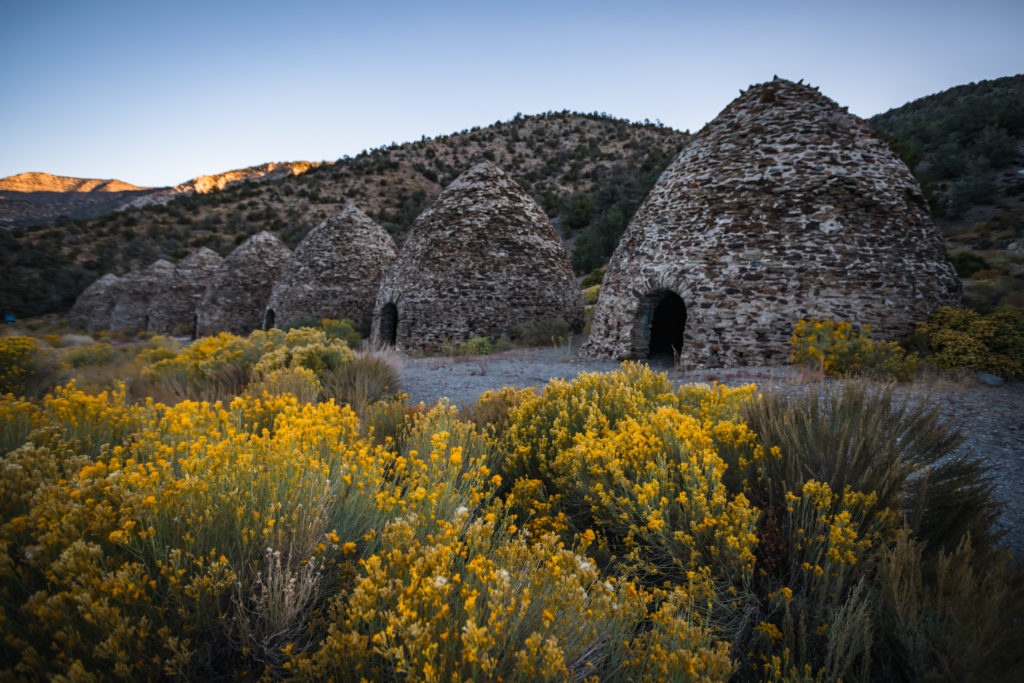
Be sure to check out my Death Valley archive here for more first-hand tips for exploring!
Before heading into National Parks, it’s imperative that you’re familiar with the “Leave No Trace” principles.
Read More: Leave No Trace: The 7 Rules of the Backcountry
Learn more about Leave No Trace on their website here.
Like This Post? Pin It!

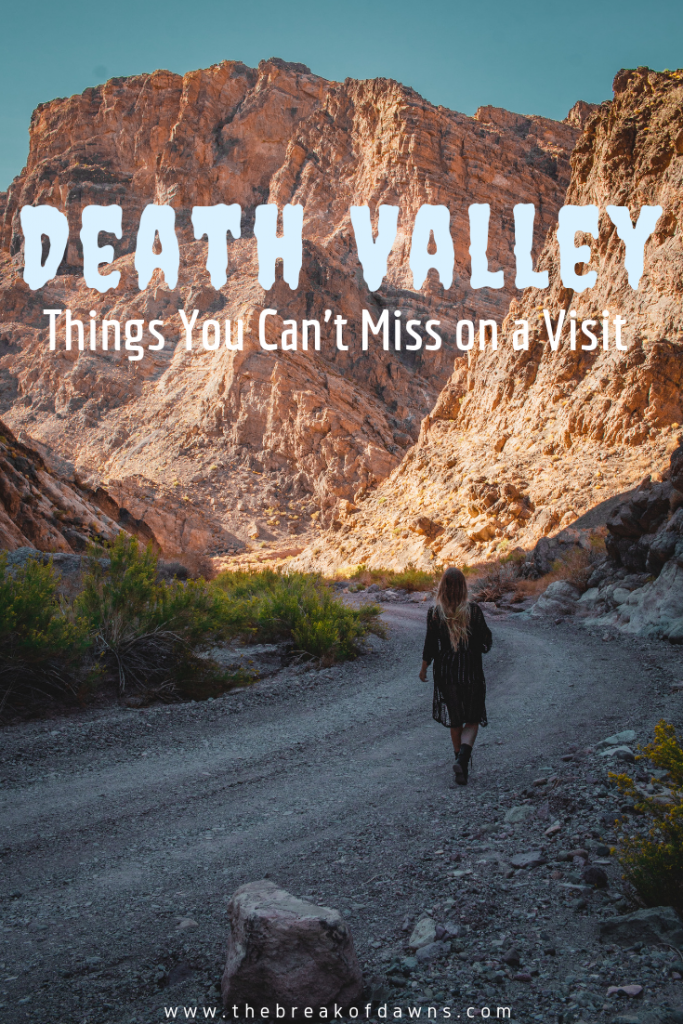
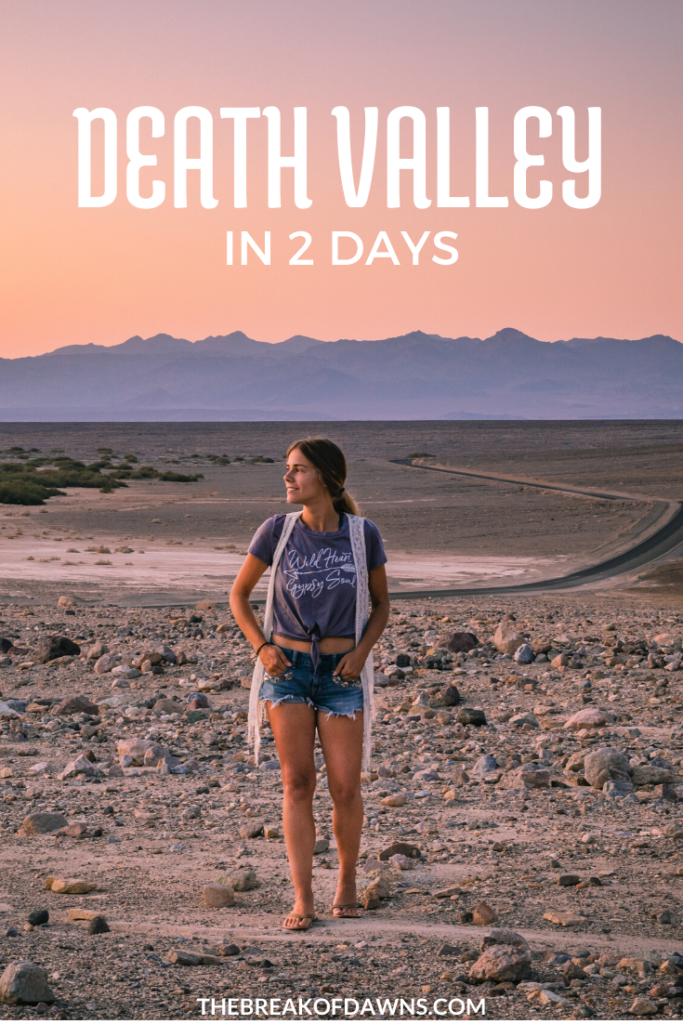
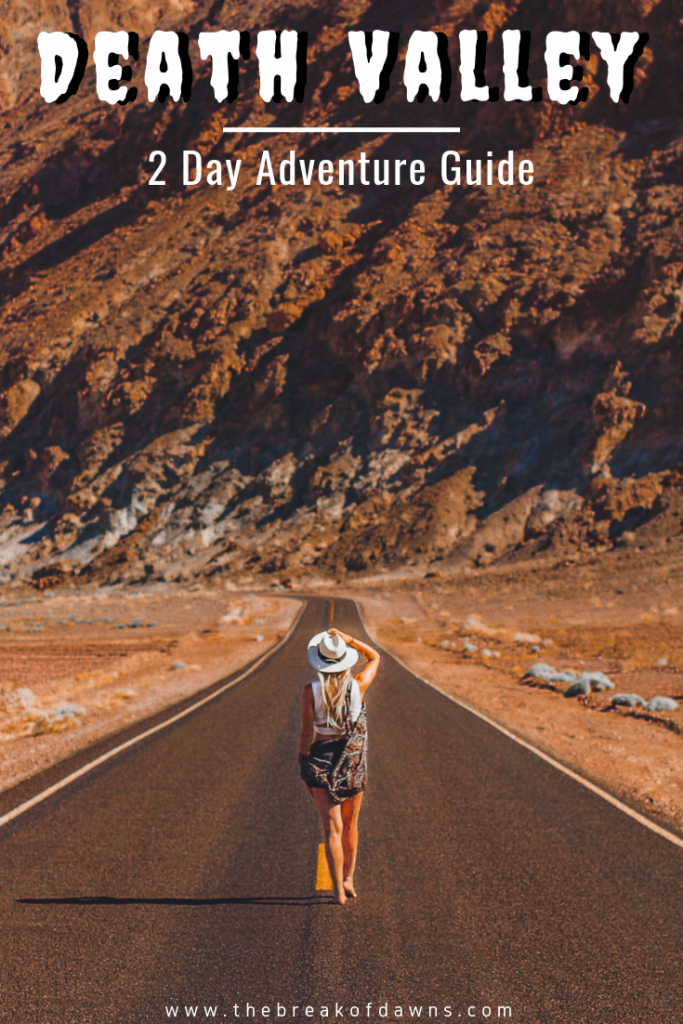
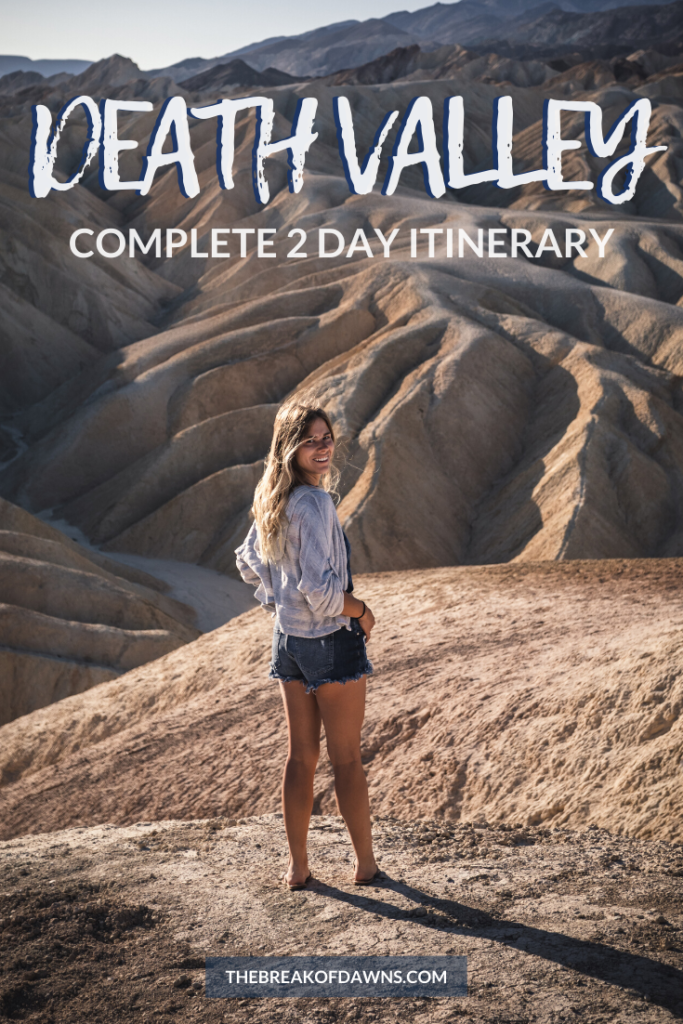
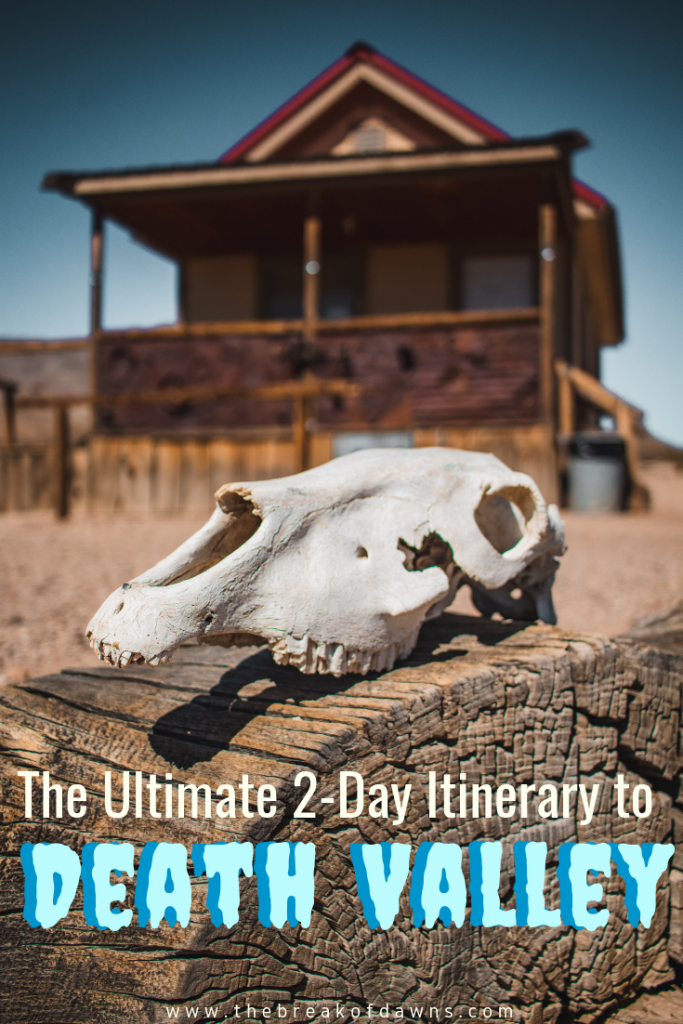
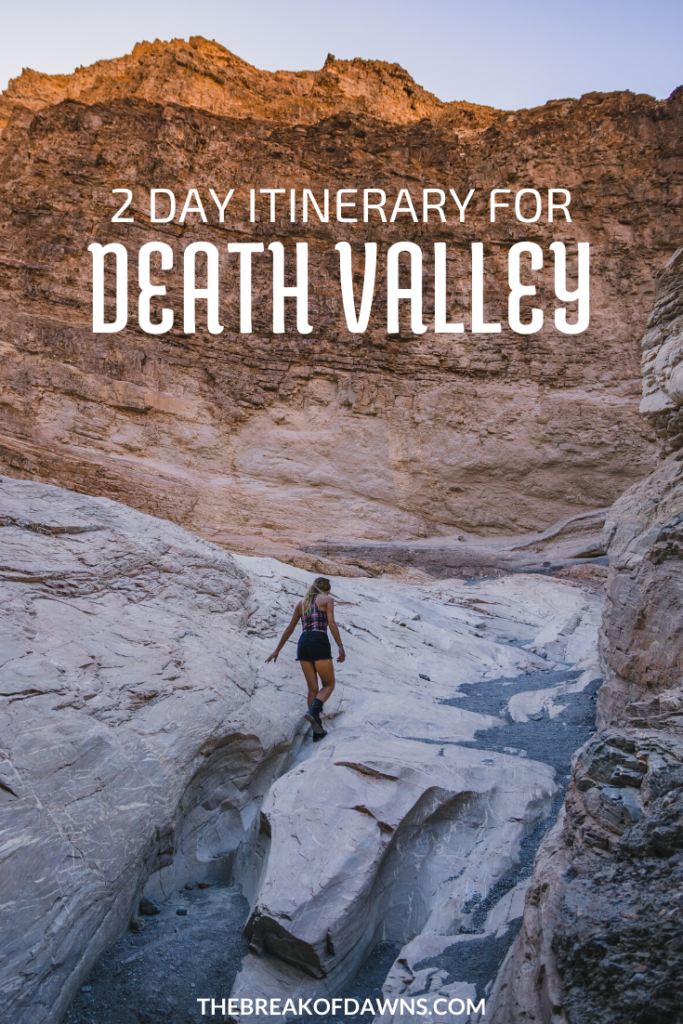
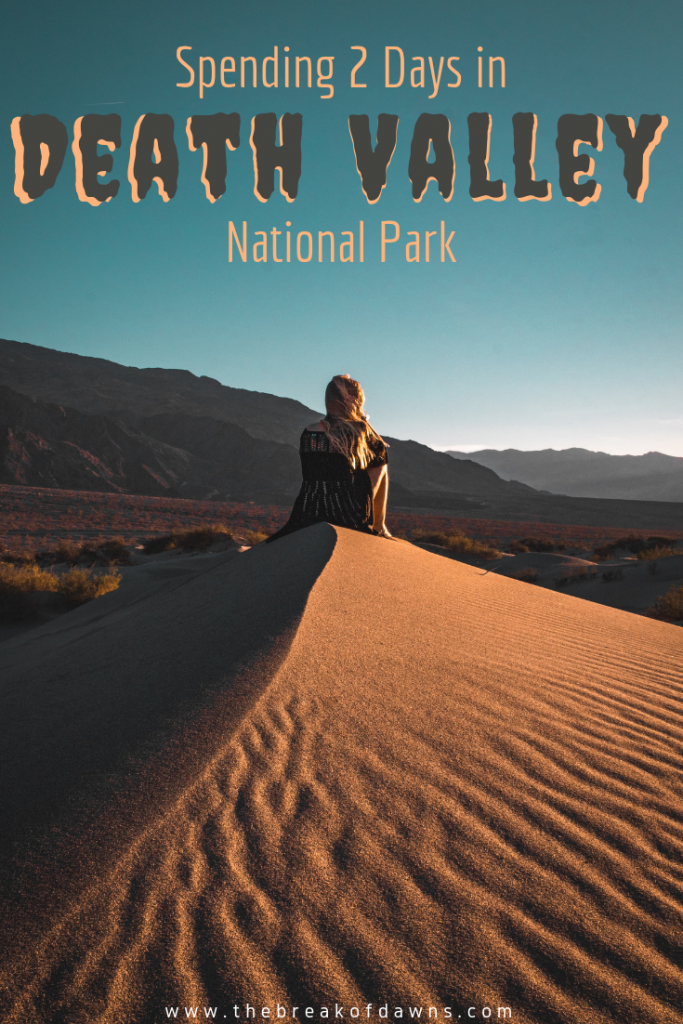
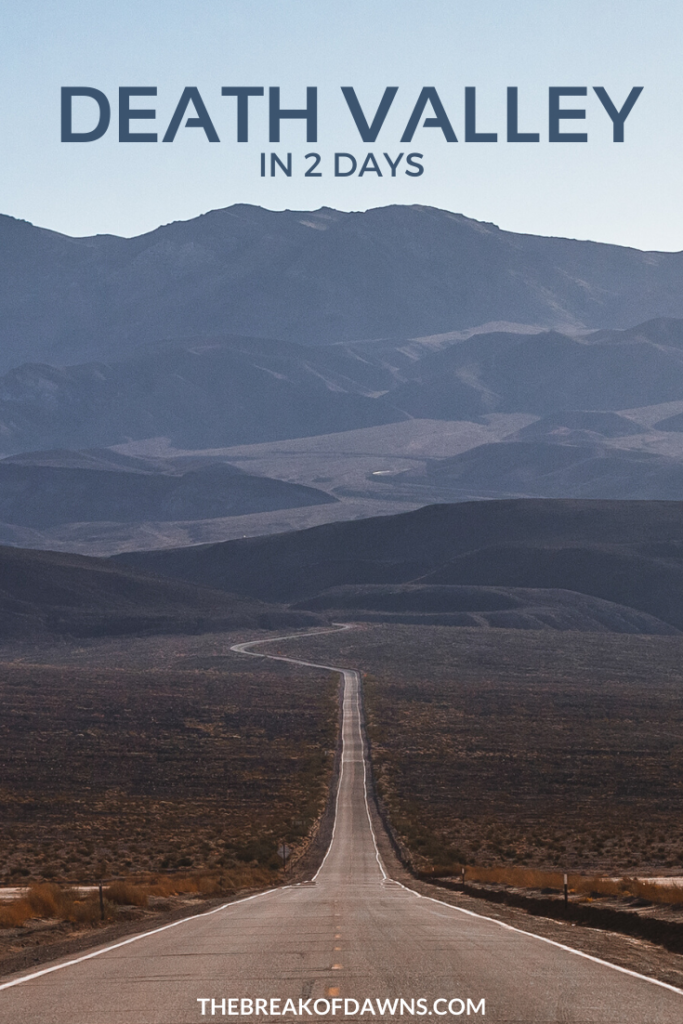
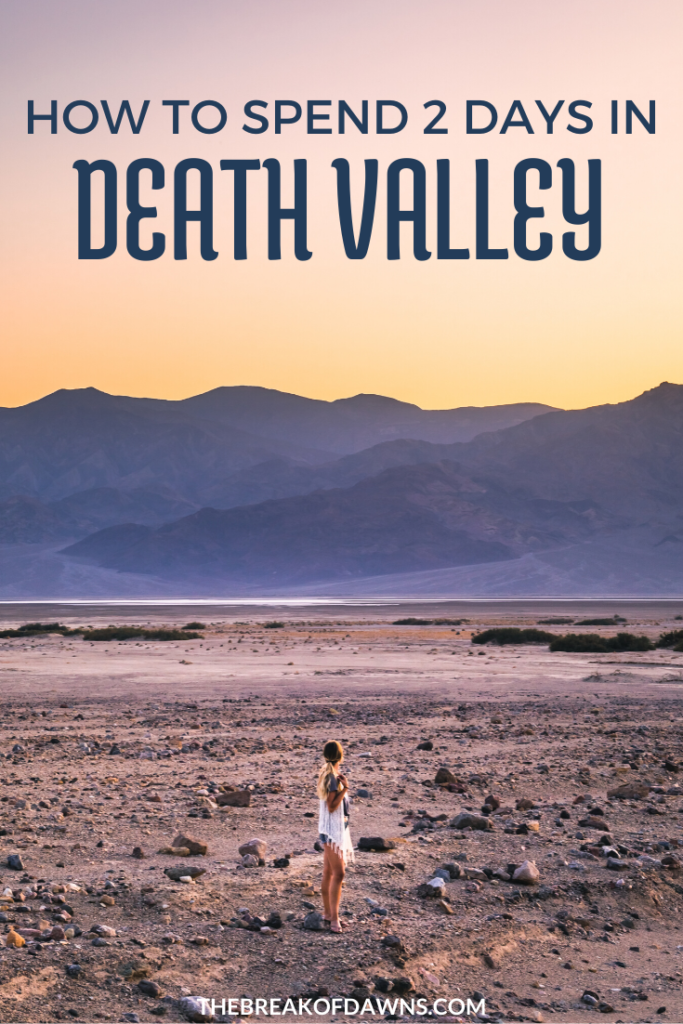
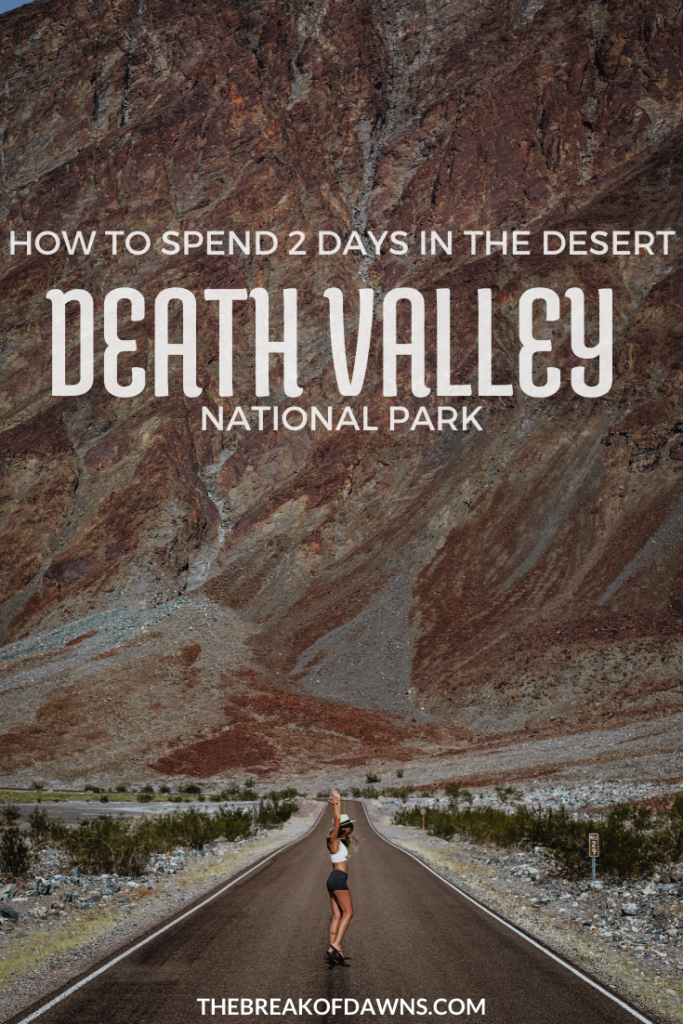
| This post contains affiliate links. At no extra cost to you, if you purchase one of these products I may receive a small commission. This helps me maintain my blog as a free space to you. Check out my Disclaimer for more info.

